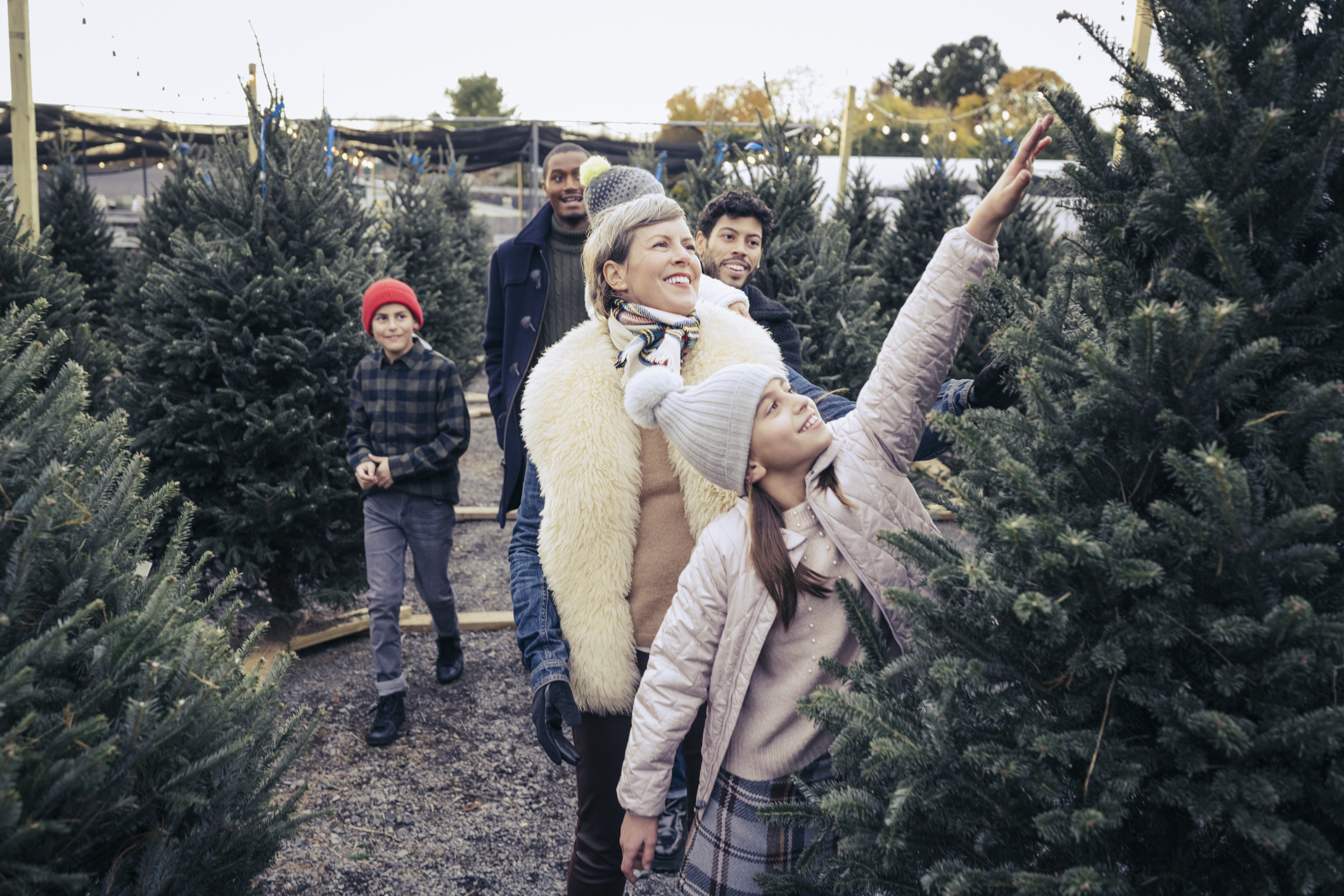Fake vs. Real Christmas Tree: Which Will Save You More?
We pit fake Christmas trees vs. real ones to see which is the better value in the long run.

The fake vs real Christmas tree debate has been simmering on for years. Traditionalists and romantics point to the festive smell and that sense of bringing the natural world into your home. Pragmatists point to the practicality of reusing the same tree year after year.
But, depending on your choice, you could be saving money every year. We take a look at the pros and cons of the great tree debate.
The benefits of a fake Christmas tree

If you've stuck with real trees for years, but are considering making a switch, here are some of the key benefits to consider when getting a fake tree.
From just $107.88 $24.99 for Kiplinger Personal Finance
Become a smarter, better informed investor. Subscribe from just $107.88 $24.99, plus get up to 4 Special Issues

Sign up for Kiplinger’s Free Newsletters
Profit and prosper with the best of expert advice on investing, taxes, retirement, personal finance and more - straight to your e-mail.
Profit and prosper with the best of expert advice - straight to your e-mail.
Reusable
This is pretty obvious. You can reuse a fake Christmas tree every year. If you’re on a budget and don't want to splurge every year, this is your best bet. Plus, most fake trees come in sections, meaning they can be easily stored, ready to come out the next year.
No maintenance or mess
As your tree is fake, there’s no watering, sweeping of needles, or trimming. Most real Christmas trees involve some kind of daily maintenance to keep them looking good, just like a vase of fresh cut flowers.
You may not even have to struggle to put the lights on every year. Most fake trees already have lights on them. There are even some ingenious pop-up versions, that store away in their own carry case! And the best part — you won’t have to squash the tree into your car or drag it along your driveway every year.
Cost
Artificial Christmas trees can range from about $85 to $1,000 or more. “According to our 2023 survey, 52% of artificial Christmas tree owners purchased their tree for under $200, and 27% paid $200 to $400,” says Jami Warner, executive director of the American Christmas Tree Association.
The quality and appearance can also vary substantially between budget-friendly trees and the higher price tiers. If you're hoping to reuse this fake tree year after year, it's worth splurging a bit now on one that you'll still enjoy looking at years from now.
Just remember that all products have a lifespan. On average, artificial Christmas trees are used for about 10 years, according to a Life Cycle Assessment comparing real and artificial trees. So, you don't want to spend more on a fake tree than you would on roughly 10 real trees.
Earning cash back on every purchase can help put a little money back in your pocket. See Kiplinger's top credit card picks for online shopping, powered by Bankrate. Advertising disclosure.
The benefits of a real Christmas tree

For some traditionalists, there's no need to even list out the benefits of sticking with a real tree. Even the most convincing fakes don't compare to the cozy, holiday feel of the real deal. Still, from a purely practical standpoint, here are some of the benefits of a real tree to consider before switching to a fake.
The natural scent
Most people look forward to this part the most — the fresh smell of fir or pine spreading throughout your house. You can keep an evergreen candle lit near your fake tree but nothing can truly substitute for the festive smell of a real Christmas tree.
The experience of choosing a tree
Whether you go to the lot outside the grocery store or to an actual tree farm, the process of picking out this year's perfect tree is one of those holiday traditions that many families love.
Of course, if your kids are grown or you've just never really enjoyed that aspect of the holiday, this might seem more like a chore than a fun experience. But, if you've got little ones, it might be worth putting up with the hassle of a real tree for a few more years to let the kids build those memories.
It's (surprisingly) the more eco-friendly option
If environmental impact is one of your concerns, you would think a reusable tree is the better choice. But the plastics and other non-renewable materials used to make trees along with the emissions produced to transport them from China can easily outweigh a real tree.
A 6.5-foot artificial tree carries a carbon footprint of about 40kg of emissions just to produce it, according to the Guardian. Meanwhile, a real tree of the same height would have a footprint of 16kg if sent to the landfill.
If you compost your real tree or take it to a tree recycling drop-off center where it can be processed into wood chips, it'll have a net negative carbon footprint.
The cost adds up, but it's still not outrageous.
On average 25-30 million Christmas trees are sold in the U.S. every year. In 2022, 22.34 million real Christmas trees were purchased and sold a median price of $80, according to the National Christmas Tree Association.
This year, most Christmas tree wholesalers said that strong supply means they won't be raising prices and some may even lower prices, according to a survey by the Real Christmas Tree Board. Being locally grown in the United States, they're also tariff free.
Of course, the cost of buying a fresh tree year after year does add up and, eventually, a fake tree will be the cheaper option. But, if you love the scent and experience of a real Christmas tree, you're not crazy for being willing to splurge $80+ once a year.
Fake vs. real Christmas trees: What's the verdict?
On price alone, a fake tree is usually the winner. A well-made fake tree might have a high initial cost. But, if you get one that lasts five years or more, it will easily cost less in the long run than buying a new tree each year.
With that said, the amount of money saved is probably less important than the amount of effort saved. Do you dread the work of dragging a tree into the house, the decorating process and the weeks of needle clean up? Then, get a fake tree to cut your holiday stress rather than your holiday budget.
If the maintenance required with a real Christmas tree is worth it for the experience (and scent) of the real deal, stick with it. One tree a year isn't expensive enough to devastate your financial future.
Related content
Profit and prosper with the best of Kiplinger's advice on investing, taxes, retirement, personal finance and much more. Delivered daily. Enter your email in the box and click Sign Me Up.
Quincy is the newsletter editor at Kiplinger. He joined Kiplinger in May 2021. Before, he worked at Agora Financial - Paradigm Press and was a contributing writer for several other online media publications.
In his current role at Kiplinger, Quincy manages all of Kiplinger's newsletters, including Kiplinger Today, Investing Weekly, Tax Tips, Kiplinger’s Special Report Closing Bell, and more.
When he’s not working, he’s taking his dog for a walk, fishing or somewhere in the world on a beach.
- Rachael GreenPersonal finance eCommerce writer
- Carla AyerseCommerce and Personal Finance Editor
-
 The Santa Claus Rally Officially Begins: Stock Market Today
The Santa Claus Rally Officially Begins: Stock Market TodayThe Santa Claus Rally is officially on as of Wednesday's closing bell, and initial returns are positive.
-
 How to Leave Different Amounts to Adult Children Without Causing a Rift
How to Leave Different Amounts to Adult Children Without Causing a RiftHere’s how to leave different amounts to adult children without causing a family rift.
-
 My Retirement Learning Curve, 1 Year In
My Retirement Learning Curve, 1 Year InA retiree checks in with what they wish they knew early on and what they've changed about their plan one year in.
-
 How to Leave Different Amounts to Adult Children Without Causing a Rift
How to Leave Different Amounts to Adult Children Without Causing a RiftHere’s how to leave different amounts to adult children without causing a family rift.
-
 Introducing Your CD's Edgier Cousin: The Market-Linked CD
Introducing Your CD's Edgier Cousin: The Market-Linked CDTraditional CDs are a safe option for savers, but they don't always beat inflation. Should you try their counterparts, market-linked CDs, for better returns?
-
 How to Protect Yourself and Others From a Troubled Adult Child: A Lesson from Real Life
How to Protect Yourself and Others From a Troubled Adult Child: A Lesson from Real LifeThis case of a violent adult son whose parents are in denial is an example of the extreme risks some parents face if they neglect essential safety precautions.
-
 Here's How Much You Can Earn with a $100,000 Jumbo CD
Here's How Much You Can Earn with a $100,000 Jumbo CDYou might be surprised at how fast a jumbo CD helps you reach your goals.
-
 A Financial Planner Takes a Deep Dive Into How Charitable Trusts Benefit You and Your Favorite Charities
A Financial Planner Takes a Deep Dive Into How Charitable Trusts Benefit You and Your Favorite CharitiesThese dual-purpose tools let affluent families combine philanthropic goals with advanced tax planning to generate income, reduce estate taxes and preserve wealth.
-
 How Financial Advisers Can Best Help Widowed and Divorced Women
How Financial Advisers Can Best Help Widowed and Divorced WomenApproaching conversations with empathy and compassion is key to helping them find clarity and confidence and take control of their financial futures.
-
 Your Guide to Buying Art Online
Your Guide to Buying Art OnlineFrom virtual galleries to social media platforms, the internet offers plenty of places to shop for paintings, sculptures and other artwork without breaking the bank.
-
 Samsung Galaxy S25 Ultra for $4.99 a Month: A Closer Look at Verizon’s Deal
Samsung Galaxy S25 Ultra for $4.99 a Month: A Closer Look at Verizon’s DealVerizon’s aggressive pricing makes Samsung’s top-tier phone tempting, but the real cost depends on your plan and how long you stay.
